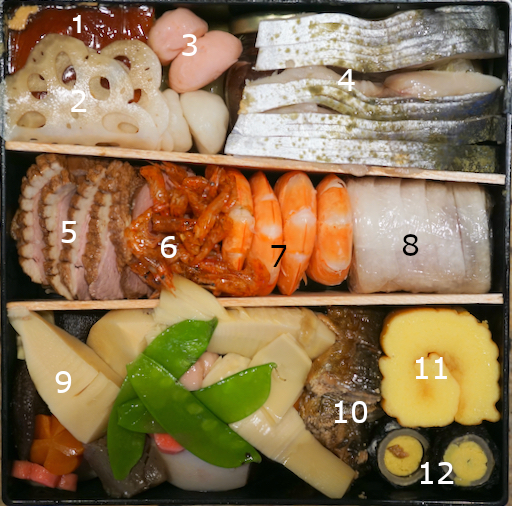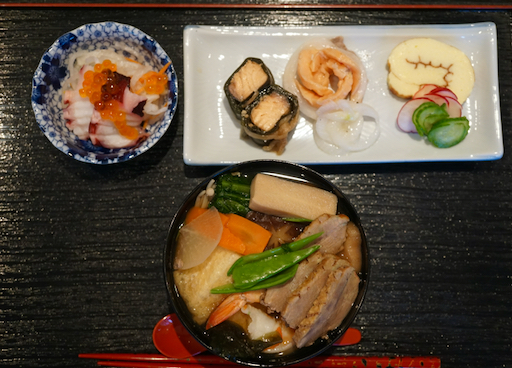It is morning of the first day of 2023. The past year was marked by many events; not the least of which is the still lingering COVID-19. In any case, here is the “
Kagami-mochi” 鏡餅 New Year’s decoration. It is accompanied by various rabbit figurines because this is the year of the rabbit according to the Chinese zodiac. We usually place the new year’s decoration in the
tokonoma 床間 alcove of our “tearoom” in the basement but this year, we decided to place it in the room where we spend most of our time to maximize our enjoyment of the collection.
As usual, the highlight of our new year is the Sushi taro osechi box 寿司太郎お節箱. We drove down to Dupont circle and picked up the
Osechi box and hand-cut soba noodles “
toshikoshi soba” 年越しそば (which we usually enjoy the 2nd day of the new year). For many years, we traditionally have our regular breakfast of
Cafe Latte with yogurt and breads and have the New Year’s “Ozouni” お雑煮 soup for lunch. I also served a few items I made. As always, we wheeled out the real Japanese laquer ware bowls my mother gave us a long time ago.
As usual, we encased the mochi in a fried tofu pouch or “abura-age” 油揚げ (in an effort to make the eating experience a bit more manageable). It is at the bottom of the bowl so you can’t see it in the picture. I cut the carrot into a flower-shape and the daikon into a ginko leaf-shape. I also added burdock root ごぼう (the white rectangular object in the picture), shiitake mushroom, shrimp, flower-shape gluten cakes or “fu” 麩, snow pea, scallion and yuzu zest (frozen). I made the broth from dashi packs, a bit of mirin and x4 Japanese noodle sauce.
The accompanying dishes (from left to right) are all listed in “
Norio’s New year dishes”. They are: chicken squares with gorgonzola cheese and dried fig, salmon kelp roll 鮭の昆布巻き, datemaki omelet 伊達巻, and salmon Russian marinade. (This year I made some modifications to the marinade by adding Dijon mustard and dill). Of course it wouldn’t be an adequate celebration of the first day of the New Year without at least a token glass of sake. This year it was our house favorite
Tengumai Daiginjo 天狗舞大吟醸. The soup and these items were pretty good if I do say so myself.
Although we did not tap into the osechi box, here is a preview of what to expect when we eagerly dive in this evening. The picture below shows the first tier. Although many goodies are hidden below the items we can see, we can spot our favorites like “karasumi” 唐墨, “mushi uni” 蒸し雲丹 and “Kazunoko” 数の子.
The second tier also has our favorites such as “Ankimo tofu”, “Ikura” and duck breast.
We are repeating ourselves but it is so wonderful that we are able to get this incredible osechi from Sushi Taro. We will be enjoying these delicacies over the next few days.



















































